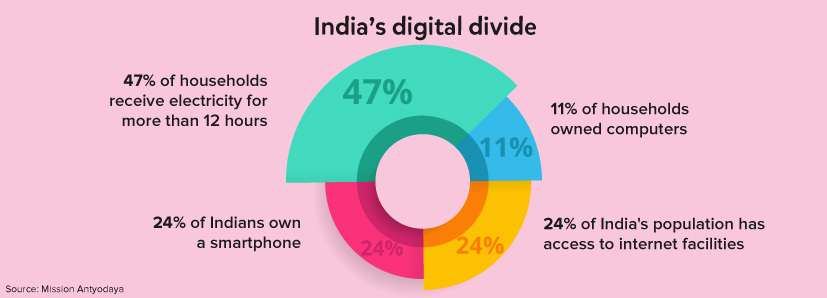
The ongoing pandemic has changed the world as we know it. And while most discussions shine the spotlight on the race to develop a vaccine, the shrinking economies, and our frozen social lives; the education and future of our posterity has sadly been languishing in a blind spot, especially in India! This has hampered the very democratization of education, especially impacting the already disadvantaged sections of society.
Now picture this — most countries around the world have shut educational institutions to halt the spread of COVID-19. In fact, as of July 27, 2020, about 1.725 billion learners[1] have been impacted by school closures. In other words, 98.6% of the world’s student population does not have clarity on the way forward, according to UNICEF.
In India alone, UNICEF has estimated that 247 million children have been stripped-off elementary and secondary education, in addition to 28 million[2] children who have no access to pre-school education in Anganwadis. Now let’s take a closer look at the crisis at hand.


According to a report by Human Rights Watch, more than 1.5 billion students[3] are already out of school. And what makes the situation all the more unique in India?
In 2016, the Annual States of Education Report (ASER) survey in rural India suggested that around 3.5% of children between the ages of 11 and 14 years, and 13.5% of children between the ages of 15 and 16 years were dropouts[4].
Now, India has consistently combated the high dropout and low enrollment rates through the Midday Meal Scheme. In fact, enrollments increased by 30% after its implementation according to IJIRMF[5]. Needless to say, the continued closure of schools has us staring at the world’s highest dropout rate.

Even before the pandemic brought our lives to a grinding halt, the Indian education system was posed with the problem of untrained teachers and high vacancies.
According to the World Bank,[6] only half of India’s public school teachers actually teach on any given day due to poor transportation facilities or owing to lack of infrastructure. And nearly one in five primary school teaching posts is vacant with only a single teacher running a school in rural areas.
With several teachers unable to teach when schools were actually open, it is hard to picture a smooth transition into remote teaching during the lockdown.

While most private schools have begun online classes and are leveraging digital tools to continue teaching, public schools are still grappling with the lack of infrastructure and teacher training. Additionally, several private schools already had access to e-learning systems as opposed to public schools that are yet to be equipped.

While there is no doubt that the best way to continue educating learners during the pandemic would be to take classes online — the real question to ask is if rural, disadvantaged families have the prerequisites to be a part of this move.

According to Mission Antyodaya’s [7] nationwide survey of villages, only 47% of households receive electricity for more than 12 hours a day. Additionally, only 24% of Indians own a smartphone, and only 11% of households owned computers. On the whole, a scarce 24% of India’s population has access to internet facilities.

A multi-pronged approach is needed to ensure that every child receives the Right to Education. For starters, learners will need to be incentivised to enroll and not drop out in a bid to support their financially strained families. Secondly, public school teachers will need to be brought up to speed with the latest in ed-tech and be given enough training and support. Lastly, learners will need to be equipped with devices and steady internet connectivity to access online classes and other learning aids.
And as India’s largest EdTech company, BYJU’S, we are doing our bit by launching ‘Education for All’, a social movement to democratise education in these extraordinarily difficult times. To achieve this we’ve collaborated with mission-aligned partners to help mobilise resources and bridge the digital divide by creating seamless access to quality education for children in need. And in this journey we’ve joined hands with some notable organisations to work closely with government schools.

As the first step towards this mission we’ve introduced the ‘Give Initiative’, a tech-driven outreach program to empower children from underserved communities with refurbished devices powered by BYJU’S learning programs.
By securing the future of our young learners through quality education today, we are sure to empower them to be independent, productive, and happy citizens in the years to come. So visit us here to join our movement in democratising education!
References
[1] [2] Urgent action needed to safeguard futures of 600 million South Asian children threatened by COVID-19, UNICEF
[3] Why Covid-19 Choices Are Critical for Children, Humans Right Watch
[4] Annual Status of Education Report (Rural) 2016
[5] Impact of Mid-Day Meals Programme on Enrolment and Retention of Primary School Children, IJIRMF
[6] Educating India’s Children, World Bank
[7] Mission Antyodaya
Divya Swamy is a Bangalore-based writer with a passion for education. She believes that words have the power to uplift people and hopes to use her voice to galvanise change. In her free time, she loves to cook, watch movies, and tend to her plants.